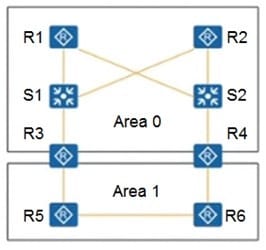Exam Details
Exam Code
:H12-261Exam Name
:HCIE-Routing & Switching (Written) V3.0Certification
:Routing & SwitchingVendor
:HuaweiTotal Questions
:494 Q&AsLast Updated
:Jan 17, 2024
Huawei Routing & Switching H12-261 Questions & Answers
-
Question 1:
You need to ensure that only Telnet traffic can access the server whose IP address is 10.1.1.100. You configure the following ACL on the router:

Then you apply the ACL to the inbound direction of the router's serial interface. Which of the following types of packets are allowed to pass through the router?
A. Non-fragmented packets that access the server through port 21.
B. Non-initial fragments that access the server through port 23.
C. Non-initial fragments that access other hosts.
D. Non-initial fragments that access the server through port 21.
E. Initial fragments or non-fragmented packets that access the server through port 23.
-
Question 2:

OSPF has been configured on R1 as shown above, but R1 does not learn the routes from any other
routers, which of the following are possible causes? (Choose all that apply.)
A. The area ID configured on R1 is different from that configured on its neighbors.
B. The network address advertised by R1 does not match the interface mask.
C. No OSPF process ID is configured on R1.
D. The authentication function is not configured on R1, but configured on its neighbors.
-
Question 3:
An enterprise sets up an OSPF network with the topology and areas shown in the diagram. OSPF adjacencies are formed between all devices on all links and all loopback interface addresses are advertised by OSPF. A fault occurs and the links from R1 to S2 and R2 to S1 fail. Which of the following statements are true? (Choose all that apply.)

A. R5 can learn the route to the loopback interface of R2.
B. R3 can learn the route to the loopback interface of R2.
C. R1 can learn the route to the loopback interface of R2.
D. R3 can not learn the route to the loopback interface of R2.
-
Question 4:
Which of the following statements regarding the assert mechanism is true?
A. The assert mechanism is used for DR election
B. In the assert mechanism, the winner forwards multicast data to the broadcast network
C. In the assert mechanism, the loser shutdown the interface connected to the broadcast network
D. IP addresses are not used for winner election
-
Question 5:
Which of the following statements regarding MPLS BGP VPN is false?
A. PEs and CEs can exchange routing information using static routes, OSPF multi-instance, IS-IS multi-instance, and EBGP.
B. BGP SoO is used to prevent the routes advertised from a VPN site from returning to the site after traversing the MPLS backbone network. SoO is an extended community attribute automatically generated by MP-BGP.
C. Typically, PEs at both ends of an IBGP session establish, a stable BGP peer relationship using the loopback interface address.
D. The TTL field in the label is used to prevent loops.
-
Question 6:
On a shared network, which of the following mechanisms is used by PIM-SM to prevent duplicate traffic?
A. Register mechanism
B. BSR/RP mechanism
C. Assert mechanism
D. Join/Prune mechanism
-
Question 7:
In RSTP, which port type can provide a backup path to the root of the spanning tree and what is the state of this type of port?
A. Root port in Listening state
B. Alternate port in Forwarding state
C. Alternate port in Learning state
D. Designated port in Listening state
E. Alternate port in Discarding state
-
Question 8:
Which of the following SDN controllers uses VXLAN technology?
A. Agile Controller-DCN
B. Agile Controller-WAN
C. Agile Controller-Campus
-
Question 9:
Which of the following statements regarding the process in which the source DR registers with the RP on a PIM-SM network is true?
A. The Register message is a multicast packet
B. The Register message is used to set up an RPT between the source DR and RP
C. After receiving the Register message, the RP sends a Register-Stop message
D. The Register message carries multicast service data
-
Question 10:
A router receives a BGP route carrying the no-export community attribute. How will the router process this BGP route?
A. The router will discard it
B. The router will not advertise it to other BGP routers
C. The router will advertise it to IBGP peers only
D. The router will advertise it normally, but does not forward data through this route
Related Exams:
Tips on How to Prepare for the Exams
Nowadays, the certification exams become more and more important and required by more and more enterprises when applying for a job. But how to prepare for the exam effectively? How to prepare for the exam in a short time with less efforts? How to get a ideal result and how to find the most reliable resources? Here on Vcedump.com, you will find all the answers. Vcedump.com provide not only Huawei exam questions, answers and explanations but also complete assistance on your exam preparation and certification application. If you are confused on your H12-261 exam preparations and Huawei certification application, do not hesitate to visit our Vcedump.com to find your solutions here.